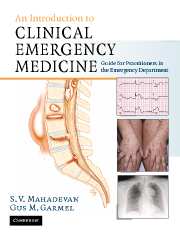Book contents
- Frontmatter
- Contents
- List of contributors
- Foreword
- Acknowledgments
- Dedication
- Section 1 Principles of Emergency Medicine
- Section 2 Primary Complaints
- Section 3 Unique Issues in Emergency Medicine
- Section 4 Appendices
- Appendix A Common emergency procedures
- Appendix B Wound preparation
- Appendix C Laceration repair
- Appendix D Procedural sedation and analgesia
- Appendix E Focused assessment with sonography in trauma
- Appendix F Interpretation of emergency laboratories
- Index
Appendix E - Focused assessment with sonography in trauma
Published online by Cambridge University Press: 27 October 2009
- Frontmatter
- Contents
- List of contributors
- Foreword
- Acknowledgments
- Dedication
- Section 1 Principles of Emergency Medicine
- Section 2 Primary Complaints
- Section 3 Unique Issues in Emergency Medicine
- Section 4 Appendices
- Appendix A Common emergency procedures
- Appendix B Wound preparation
- Appendix C Laceration repair
- Appendix D Procedural sedation and analgesia
- Appendix E Focused assessment with sonography in trauma
- Appendix F Interpretation of emergency laboratories
- Index
Summary
Background
The focused assessment with sonography in trauma (FAST) is an important bedside examination used primarily by emergency physicians and trauma surgeons to identify free intraperitoneal, intrathoracic, or pericardial fluid. Physicians in Europe and Japan have been using bedside ultrasound (US) in the routine evaluation of trauma patients for over 30 years. The FAST exam has gained wide acceptance in the United States in the past decade. No other imaging modality has the ability to diagnose critical traumatic conditions as quickly or as accurately as bedside US. Ultrasonographic techniques are noninvasive, do not expose patients to radiation, and are performed with relatively inexpensive portable equipment. In the initial assessment of trauma patients, abdominal US is now replacing diagnostic peritoneal lavage (DPL), and echocardiography has replaced invasive subxiphoid pericardiotomy. With increasing numbers of emergency medicine residency programs incorporating formal US training into their curriculum, its role in emergency medicine practice is being further solidified.
Equipment
Essential components of US equipment are accessibility, portability, reliability and ease of use. Most trauma centers now have portable machines on site ready to be wheeled to the bedside at a moments notice. While most machines come with a variety of transducers, the most commonly-used transducer for the FAST examination is a 3.5MHz microconvex transducer. The main advantage of the microconvex transducer is that the footprint can easily fit between the ribs when evaluating the upper quadrants and the heart.
- Type
- Chapter
- Information
- An Introduction to Clinical Emergency MedicineGuide for Practitioners in the Emergency Department, pp. 733 - 738Publisher: Cambridge University PressPrint publication year: 2005

